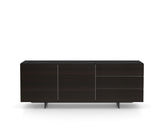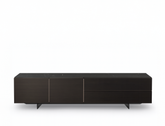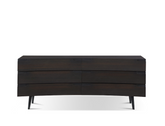Bedside Table Sizing Made Simple

Bedside tables are essential furniture pieces in any bedroom, offering both style and functionality. Positioned next to your bed, they provide convenient storage for items you might need while relaxing, such as books, glasses, or an alarm clock. Bedside tables often feature drawers and compartments, making them ideal for storing small essentials like towels or seasonal clothing.
While the standard bedside table height is typically around 25 inches for an average bed, the ideal width is usually about 20 inches. However, this is not a one-size-fits-all rule; several factors should influence your decision. Read on to learn how to choose the right bedside table width for your bedroom.
Factors to Consider When Choosing Bedside Table Width
1. The Size of Your Bedroom
The dimensions of your bedroom play a significant role in determining the appropriate bedside table width. If you have a larger room, you might opt for a more expansive piece that complements the space. Conversely, smaller bedrooms, such as those commonly found in compact living spaces like apartments, require more careful consideration.
For instance, in places like Singapore, where space can be limited, smaller bedside tables are often preferred to avoid overcrowding. A standard bedside table size ranges from 20 to 28 inches in width. However, in a smaller bedroom, you may want to consider a narrower table to maintain a balanced and uncluttered look.
If your bedroom allows for it, you might even mix and match by placing two compact nightstands on either side of the bed. This approach not only saves space but also adds a touch of symmetry and style to your bedroom design.
2. The Size of Your Bed Frame and Mattress
The dimensions of your bed frame and mattress are crucial in selecting the right bedside table width. A bedside table that is too wide or too narrow can disrupt the balance of your bedroom’s aesthetics.
-
Single and Super Single Beds: These typically require a narrower bedside table to maintain proportion. A table that is too wide could overwhelm the space, making the room feel cramped.
-
Queen Beds: A standard 20-inch wide bedside table works well with a queen bed, providing a harmonious balance between the furniture pieces.
-
King Beds: A king bed, being larger, can accommodate wider bedside tables. A 25-inch wide nightstand can balance the scale of a king bed effectively. Alternatively, you could use two smaller or standard-sized nightstands to create a cohesive look.
3. Storage Needs
When selecting a bedside table, consider your storage needs. A bedside table should be functional, providing convenient access to items you use frequently.
-
Tabletop Space: Ensure the tabletop is spacious enough for items you want to keep close, such as a lamp, decor, books, or a glass of water. The width of the table directly impacts how much you can place on it without it feeling cluttered.
-
Drawers and Shelves: Consider how much storage space you need. If you require ample storage, choose a bedside table with multiple drawers or shelves. Closed drawers are ideal for storing items like eyeglasses, remote controls, or small accessories that you want to keep out of sight. Open shelves can be used to display books or decorative items, adding a personal touch to your bedroom.
The right combination of drawers and shelves can help you stay organized while enhancing the functionality of your bedside table.
4. Personal Style Preference
Your style preference is perhaps the most personal and subjective factor when choosing a bedside table. Your bedroom is your sanctuary, and your furniture should reflect your taste and personality.
-
Matching vs. Mismatching: You might prefer a pair of matching bedside tables for a classic and cohesive look. However, mixing and matching two tables of different sizes can create a unique, eclectic vibe that adds character to your bedroom.
-
Design Elements: Experimenting with different bedside table designs allows you to find the perfect piece that ties your room together. Whether you prefer a sleek, modern look or something more rustic, your bedside table should enhance the overall aesthetic of your bedroom.
Incorporate elements that resonate with your style, such as specific finishes, materials, or colors. The bedside table should not only be functional but also add to the comfort and warmth of your space.
Conclusion: Choosing the Ideal Bedside Table Width
Selecting the right bedside table dimensions is key to creating a comfortable and functional bedroom. Whether you opt for a compact table for a smaller room or a more spacious one for a larger space, the table should be accessible and meet your needs.
When choosing the width, consider the size of your bedroom, the dimensions of your bed, your storage needs, and your personal style preferences. By carefully considering these factors, you can find the perfect bedside table that complements your bedroom's overall design while providing the necessary functionality.
Frequently Asked Questions (FAQs)
1. What is the standard width of a bedside table?
The standard width of a bedside table typically ranges from 20 to 28 inches. However, the best width for your space will depend on factors like bedroom size, bed frame dimensions, and personal storage needs.
2. Can I use a bedside table that is narrower than 20 inches?
Yes, you can use a bedside table that is narrower than 20 inches, especially if you have a smaller bedroom or a single bed. Narrower tables can help maximize space without making the room feel cramped.
3. Should bedside tables match the bed frame in style?
While it’s not necessary for bedside tables to exactly match the bed frame, they should complement the overall design and style of your bedroom. Mixing styles can work well if there are common elements that tie the pieces together.
4. How many bedside tables should I have in my bedroom?
Typically, one bedside table is placed on each side of the bed for balance. However, in smaller bedrooms, you might opt for just one. The decision ultimately depends on your space, storage needs, and design preference.
5. What should I consider when choosing the height of a bedside table?
The height of the bedside table should be roughly the same as the top of your mattress, making it easy to reach items while in bed. The standard height is usually around 25 inches, but this can vary based on your bed’s height.
6. Is it okay to have mismatched bedside tables?
Yes, mismatched bedside tables can add character and interest to your bedroom. The key is to find pieces that complement each other in some way, whether through color, material, or design elements.
By following these guidelines and answering these common questions, you’ll be well-equipped to choose the perfect bedside table for your bedroom, ensuring both functionality and style.
Looking for stylish bedside tables? Browse through Prestige Affairs Furniture's extensive collection of bedside tables in Singapore.







